|
Types of Irrigation Systems
Landscape irrigation devices can be divided into two major types: point-source and spray. Spray irrigation is suitable for lawns and groundcovers. Drip irrigation is suitable for any shrubs or plants that are purchased in 1 gallon or larger containers.
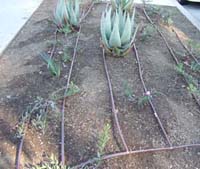
Drip irrigation
|
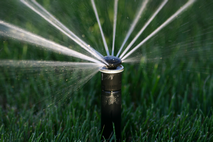
Sprayhead with rotary nozzle
|
What is Spray and Point-Source Irrigation?
Watering Device
|
Description
|
Radius of Water Spray
|
Spray Irrigation
|
Rotor / Impact
|
Sprinklers with one or more rotating streams of water for very large areas, like parks.
|
15’ to 60’
|
Sprayhead
|
Sprinklers with a fan-shaped spray pattern. When installed with a rotary nozzle use ~ 30% less water and have a stream pattern.
|
5’ to 20’
|
Microspray
|
A mini-version of sprayheads with a very fine spray and high precipitation rates that can cause ponding.
|
2’ to 13’
|
Point-Source Irrigation
|
Bubbler
|
A device that emits water in a flowing stream. Good for trees. Install underground near tree roots (root watering system)
|
N/A
|
Drip
|
A device that emits water slowly in drops 0.5 to 2 gallons per hour. The tubing can have emitters on it (on-line tubing) or inside (in-line tubing).
|
N/A
|
Drip Irrigation
| • | Drip irrigation will use ~80% less water than traditional sprinklers. |
| • | When designed and installed properly, drip is easy to maintain, doesn't produce overspray or runoff, and has fewer weeds in the garden. |
| • | For detailed information including step-by-step design guidelines, parts list, equipment supply stores and sample plans visit www.sustainablesm.org/landscape and print out the Guidelines for Water-Efficient Irrigation Systems. |
| • | Drip lines are flexible tubing with emitters (tiny water-flow regulators in each hole in the line) evenly spaced along the tubing. Drip lines are also called inline tubing. |
| • | Some drip lines may be placed on top of the ground with an emitter(s) at each plant, and covered by a few inches of mulch. |
| • | A subsurface drip line (underground) can be used to irrigate ground covers and lawn, but an experienced designer and installer is highly recommended in the case of lawns. Be very sure to install prior to installing the lawn. Installation can occur before (in ground) or after (above ground) for groundcovers. |
| • | Water is delivered just where plants need it. This can reduce the spread of weeds and help isolate them. |
| • | Water is applied very slowly in gallons per hour (gph). For clay soils 0.5 gph is suggested. |
| • | Drip must operate at reduced pressure to deliver small amounts of water. Low flow valves, pressure regulators and filters are required. |
| • | Drip systems can be connected to a hose end and manually operated, or permanently connected to your main water source and operated by an automatic controller. |
| • | Avoid drip irrigation that is ¼” tubing. This small tubing easily gets moved by people walking over it or raking the area. The emitters at the end often heat up and pop off causing a lot of water waste. |
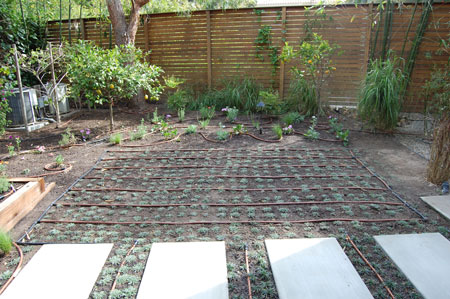
Drip irrigation using in-line 1/2" tubing
Spray Irrigation
| • | A traditional sprinkler system is about 50% efficient. Meaning you have to apply twice as much water to get even coverage. |
| • | Some spray irrigation systems emit water faster than any soil can absorb it causing runoff. This runoff picks up dirt and trash in the street as it flows to the ocean. Runoff is prohibited in most cities in LA County. |
| • | If installing new sprayheads, place them 24” away from any impermeable surfaces, like sidewalks and driveways. This may be required for some new landscapes, check with you local building or planning department. |
| • | Spray irrigation may be installed in a way that it sprays a building foundation, exterior walls, fences and benches causing them to rot quicker and require replacement. |
| • | New rotary nozzles for sprinklers make existing sprinklers more water-efficient and provide better coverage. These matched-precipitation sprinkler heads guarantee that a half-circle head will deliver just as much water per square foot as a full-circle head spraying the same distance. Matched precipitation simply means all heads deliver a uniform amount of water across each square foot of an irrigated area. Every blade of grass gets no more and no less than the next. Ask for assistance from a knowledgeable salesperson. Matched precipitation heads are currently manufactured by: Rainbird (www.rainbird.com), Hunter Industries (www.hunterindustries.com), K-Rain and Orbit. |
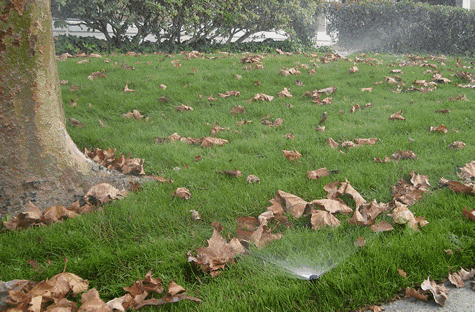
Fixed spray sprinklers.
Fixed spray, rotors, or impact sprinkler heads should be placed so water from one sprinkler head reaches adjacent sprinkler heads (head-to-head coverage).
Spray irrigation systems apply water in gallons per minute (gpm).
Sprinkler heads at the lowest point of a sloped area should be equipped with check valves. Check valves prevent run-off by not allowing the pipes to drain out of the lowest heads into the sewer and ultimately, into the ocean.
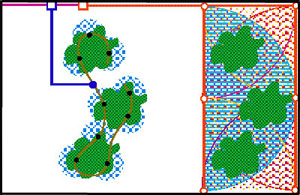
Drip Irrigation
Plant-Specific Coverage
|
Spray Irrigation
Area Coverage
|
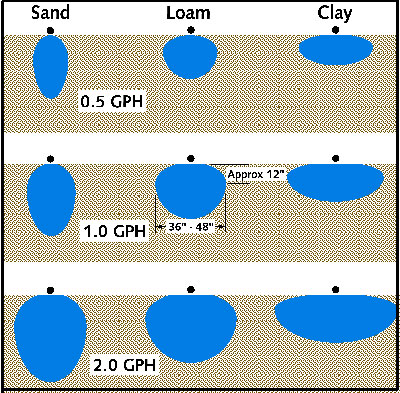
Wetting Patterns for Drippers in Various Soil Types (Idealized)
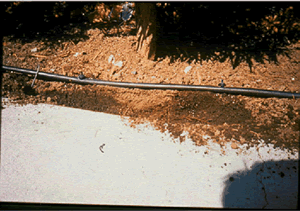
Actual cut-away of loam soil showing wetting pattern
of drippers
|
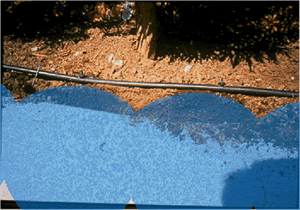
Overlay illustrating how wetting pattern produces a
continuous wetted area within the rootzone
|
|
